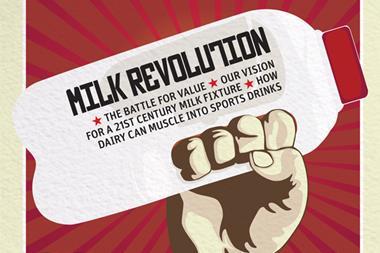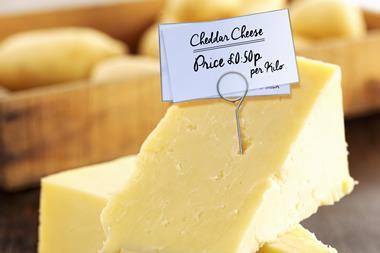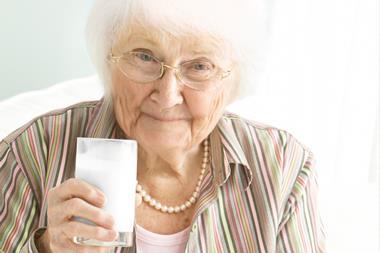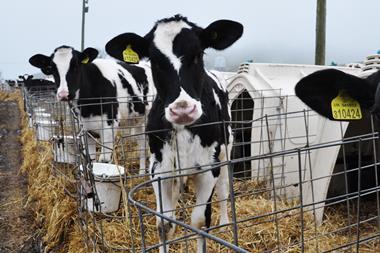The Grocer speaks to sports experts about selling the white stuff…and commissions its own bottle design…
Nutritious, low in fat, versatile and great value for money - it’s no wonder milk is the single most frequently bought grocery item, with a household penetration of more than 99% [DairyCo].
Yet despite its ubiquity, there is one area where milk has had curiously little traction to date: competing versus the fast-growing, £1.7bn sports and energy drinks market [British Soft Drinks Association, 2011].
This is odd because milk is actually supremely well-placed to become the nation’s sports drink of choice. Scientific studies show milk - the standard white stuff, with nothing added - is at least as good as, and in some cases better than, expensive, sugary, processed sports drinks in aiding post-exercise recovery, offering a potent yet natural combination of protein, to aid muscle repair, carbohydrates, to provide energy, and electrolytes to help the body absorb fluids. As Dairy Council director Dr Judith Bryans says: “With a mix of electrolytes, protein and carbohydrates, it’s a pretty good package for a sportsperson all in one.”
The growing body of evidence is starting to get through to consumers. Earlier this year, a Dairy Council-commissioned survey of 1,000 12 to 18-year-olds - a key age group for sports drinks - showed 77.6% agreed milk was “a healthy drink to have after physical activity or sports”, showing just how much potential the sports market holds for milk suppliers.
Given its robust scientific backing and consumer support, plus the fact the dairy sector is currently scratching its head over how to add value to the liquid milk category, sports-friendly formats for conventional milk - which could be sold at a premium - seem too good an opportunity to miss. So what’s holding suppliers back? And what formats and bottle shapes would be best suited for selling milk as a sports drink?
To find out, The Grocer asked design consultancy Dragon Rouge to develop five bottle designs suitable for selling standard milk as a sports drink. And we asked both leading industry experts and professional athletes and coaches to assess the designs, and the chances for milk in this market.
Retailers and suppliers have been hampered in selling milk as a sports drink partly because of protracted European Health claims legislation. No milk and sports claims have ever been submitted for approval to the European Food Safety Authority and it’s unlikely the dairy industry will submit a claim any time soon, says Bryans. EFSA guidelines on what’s needed to be successful are too vague for anyone to risk making a submission, she adds. “Until there’s some clear guidance on exactly what is required, I don’t think you’ll see anybody put a claim in because it’s incredibly costly and time-consuming.”
No EFSA-approved claim means suppliers can’t sell the benefits of milk as a sports drink on packs, but there are other strategies open to them, such as branding and marketing, as well as new formats that repackage milk in a more sports-friendly way.
“With a mix of electrolytes, proteins and carbohydrates, it’s a pretty good package for a sportsperson, all in one”
Judith Bryans, Dairy Council director
Sean Uprichard should know. The UK CEO of Robert Wiseman Dairies-backed functional milk brand A2 was the co-founder of energy drink Relentless, and believes there is great scope for promoting milk as a sports drink. It is too early to think about sports opportunities for A2, which launches in Tesco on 10 September and will be targeted at people who struggle to digest conventional milk, but Uprichard stresses branded rather than own-label milks will be best placed to tap into the sports market. “For a successful sports drink, you need to have a compelling brand story,” he says. “When we launched Relentless, we launched Relentless the word and we celebrated the attitude of Relentless. Relentless the energy drink came afterwards.”
Not everyone buys into the need for brands, though. Wendy Martinson, lead nutritionist for Team GB’s multi-Olympic medal-winning rowing team, says most serious sportspeople already know about the training benefits of milk, so there’s no need for the hard sell. “I don’t think fancy marketing is necessary because these days most athletes are aware of milk and the importance it plays in their diets.”
Instead, suppliers should focus on getting the format and pack size right, says Martinson. Selling milk in smaller quantities would make it a lot more attractive to sportspeople, with a 250-300ml portion about the right size, she suggests, adding the GB rowing team was provided with milkshakes in 250ml cartons at the 2008 Beijing Olympics and got through “roughly 2,000 in a relatively short period of time”.
Quality is definitely more important than quantity when it comes to packaging milk as a sports drink, agrees Dragon Rouge design director Jon Bailey, who spearheaded the agency’s design efforts for The Grocer. Dragon Rouge opted for formats between 330ml and 500ml to offer a sports drink that wasn’t overwhelming while at the same time not leaving consumers used to sports products around the 330ml mark short-changed.”Milk is quite a bit more substantial than water, so we wanted people to feel the recovery benefit of milk but not feel the heaviness after drinking,” adds Bailey.
Natural advantage
Suppliers would also do well to play up milk’s naturalness as against the many energy and sports drinks that contain added ingredients. “It’s natural, it’s fortified and it’s loaded with calcium. You can’t beat nature,” says Uprichard.
Then there’s the price. A one-pint (568ml) bottle of semi-skimmed milk currently costs less than 50p in the mults while a 500ml bottle of orange-flavoured Lucozade Sport is around £1.13. Whey-based sports recovery shakes are even pricier: a 330ml bottle of MaxiMilk costs from £1.87-£2.48 and a 500g bottle of For Goodness Shakes is around £1.69.
Although suppliers would be looking to sell sports milk formats at a premium to conventional bottles, milk would still be significantly cheaper than most sports drinks because it only needs to be repackaged, not reformulated, for sports use. “It would be a practical and cheap recovery drink after intense training sessions,” says Martinson.
Milk science
Loughborough University compared low-fat milk with water and a sports drink in 2007, and concluded milk was more effective in promoting recovery following “mild exercise-induced dehydration” than either.
In 2009, Northumbria University found cyclists who had drunk Mars Refuel chocolate milk (Mars was one of the study’s sponsors) cycled 51% longer than those who had drunk carbohydrate drink Endurox and 43% longer than those drinking Gatorade.
There are challenges in repackaging milk for sports use, though. Sportspeople would want to drink their milk chilled and would be concerned it will warm up in their bag if they buy it in the supermarket before practice, says Uprichard. That means suppliers would need a sophisticated distribution network to deliver chilled milk to sports arenas and gyms - a big task but not impossible, if existing distribution arrangements were tweaked somewhat, he adds.
Feedback from our panel of sports experts shows just how important it is to get these factors right. Meg Harris, captain of football club Lincoln Ladies FC, says she is already a big fan of milk and understands the role it can play in recovery, but concerns about ease of use stop her from drinking it as much as she’d like. “My main issue currently about drinking milk after training or a competition is it never stays cold enough,” she says. “Especially at away games or training sessions, storing milk where it can stay at a temperature that is desirable to consume is hard.”
Xcel Milk Nutrition, which is due to launch a sports milk drink in late September via its website, agrees that chilled distribution is a must-have to achieve scale, and is currently in talks with professional football and rugby clubs over listings. Xcel Milk will be made using fresh rather than UHT milk from Jersey cows. This delivers up to 18% more protein and 20% more calcium than Holstein milk, it claims. And it’s available in skimmed and semi-skimmed. But it’s also added whey protein, extra vitamins, and three flavours - strawberry, lime and chocolate - which, as well as adding taste, will doubtless be used to help it command a premium.
Sweaty business
Xcel’s approach to packaging also offers important lessons to standard liquid milk suppliers keen to move into the sports milk drink market. Following extensive, pre-launch research, for example, Xcel decided to create a bottle with an indented grip to help users grab it with sweaty hands post-exercise. “We also selected printed PET as a material, so the bottle substrate is tacky to touch with a sweaty hand,” adds sales and marketing manager Jenny Forrester.
Personal trainer Freddie Osie agrees that bottles need to be easy to grip and drink - but he’s also looking for a bit of the flair factor in the gym. “My main considerations would be how easy it will be to access the drink, how to store it and the temperature it will be, but another key consideration is how cool or sexy the drink looks when training,” he says. It’s one of the reasons he likes the sleek aluminium look of the Churn bottle created by Dragon Rouge. “You must keep up the cool look at all times, even when sweating!” he says.
Meanwhile, fencing cadet Rajan Rai, who says he wouldn’t typically use milk as a sports drink, believes suppliers and designers should take as much inspiration from existing sports drink bottles as possible. He picks out the Streamliner design as his personal favourite because it “reinforces the fact that milk could be a sports drink”. Because the bottle is transparent, it would also act as a constant advertisement for milk as a sports drink, he adds.
Selling standard milk as a sports drink is a fledgling concept, but larger suppliers are eyeing it with increasing interest. Take Arla-owned Cravendale, which earlier this year launched a 500ml bottle targeted at the food-to-go market. Although it has no specific plans to target sportspeople at this stage, Mike Walker, senior director of branded milk and cream at Arla, says the company is well aware of the “intrinsic” benefits of milk when it comes to sport, as well as its potential as a sports product.
But he warns conveying those benefits to consumers would require a massive educational drive and a big financial investment, which Cravendale would certainly not be willing to take on at the moment. He does, however, believe the new food-to-go format could lay the foundations for any future activity around sport, should the brand ever go down that route. “Cravendale 500ml may give us an opportunity to tap into that as a hand-held, more convenient format for sports drink going forward,” he says.
Persuading consumers to start taking a bottle of milk to the gym, track, court or pool certainly won’t be easy. But the positive feedback from athletes on Dragon Rouge’s milk bottle ideas shows perceptions can be shifted if suppliers are willing to listen to sportspeople’s needs and invest in getting the packaging right. The race is on.















No comments yet